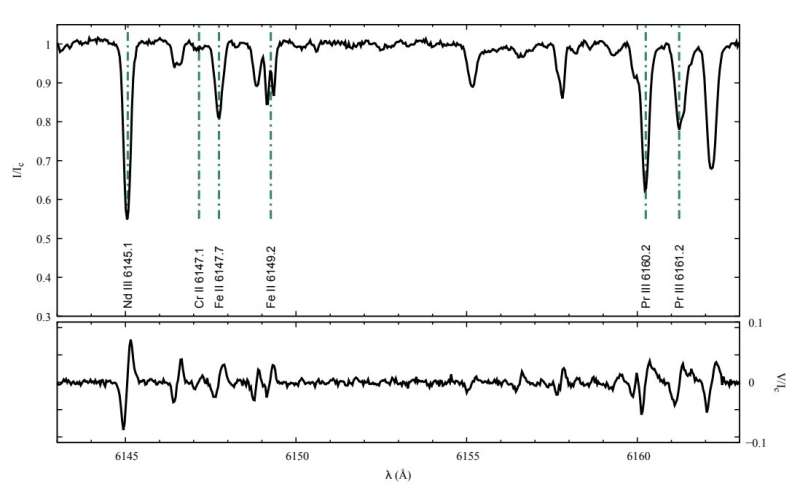January 3, 2023 report
This article has been reviewed according to Science X's editorial process and policies. Editors have highlighted the following attributes while ensuring the content's credibility:
fact-checked
preprint
trusted source
proofread
HD 213258 is a rapidly oscillating, strongly magnetic Ap star, study finds

Using the Canada-France-Hawaii Telescope (CFHT), astronomers have observed a chemically peculiar star known as HD 213258. In result, they found that HD 213258 is a rapidly oscillating, strongly magnetic Ap star. The finding is reported in a paper published December 24 on the arXiv pre-print server.
Chemically peculiar (CP) stars are those with unusual metal abundances, thus exhibiting strong or weak spectral lines for certain elements. Some CP stars are observed to have stronger magnetic fields than classical A- or B-type stars, varying from few tens of Gauss (G) to tens of kiloGauss (kG), and are hence known as magnetic chemically peculiar (mCP) stars (Ap and Bp stars). This class of objects is perceived by astronomers as a natural atomic and magnetic laboratory to study stellar formation and evolution.
Located some 363 light years away in the constellation of Lacerta, HD 213258 (also known as BD+35 4815) is CP star of spectral type A3E, estimated to be some 2.4 times bigger than the sun. The star's absolute magnitude is 2.39 mag and its effective temperature is estimated to be between 7,500 and 10,000 K.
Recently, a group of astronomers led by Gautier Mathys of European Southern Observatory (ESO) in Chile, has observed HD 213258 with the ESPaDOnS spectrograph at CFHT. The observational campaign allowed them to unveil more insights into the nature of this star.
"We report about HD 213258, an Ap star that we recently identified as presenting a unique combination of rare, remarkable properties," the researchers wrote in the paper.
ESPaDOnS was used to record Stokes I and V spectra of HD 213258 at seven epochs between November 2020 and October 2022. The study was complemented by data from NASA's Transiting Exoplanet Survey Satellite (TESS) and from the CORrelation-RAdial-VELocities (CORAVEL) spectrometer.
The observations found that the mean magnetic field modulus of HD 213258 is about 3.8 kG, with no significant variations over the observing period of two years. This finding indicates that HD 213258 is a strongly magnetic Ap star.
The astronomers estimated that the stellar rotation period of HD 213258 is of the order of 50 years, making it one of the slowest rotating Ap stars known to date. It was also found that this star is rapidly oscillating, exhibiting high overtone pulsations with a period of approximately 7.58 minutes. Hence, the researchers classified HD 213258 as a roAp—rapidly oscillating Ap star.
Furthermore, it turned out that the radial velocity of HD 213258 shows low amplitude variations, which suggests that it may be a single-line spectroscopic binary system with a low-mass companion. The researchers assume that the secondary object in this system may be a brown dwarf. If confirmed, it would make HD 213258 the first roAp star known to have a brown dwarf companion.
More information: Gautier Mathys et al, HD 213258: a new rapidly oscillating, super-slowly rotating, strongly magnetic Ap star in a spectroscopic binary, arXiv (2022). DOI: 10.48550/arxiv.2212.12752
Journal information: arXiv
© 2023 Science X Network




















